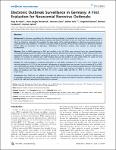Electronic Outbreak Surveillance in Germany: A First Evaluation for Nosocomial Norovirus Outbreaks
Hauri, Anja M.
Westbrock, Hans-Jürgen
Claus, Hermann
Geis, Steffen
Giernat, Siegfried
Forβbohm, Michael
Uphoff, Helmut
Background: In Germany, surveillance for infectious disease outbreaks is integrated into an electronic surveillance system. For 2007, the national surveillance database contains case-based information on 201,224 norovirus cases, three-quarters of which are linked to outbreaks. We evaluated the data quality of the national database in reflecting nosocomial norovirus outbreak (NNO) data available in 19 Hessian local public health authorities (LPHAs) and the influence of differences between LPHA’s follow-up procedures for laboratory notifications of Norovirus positive stool samples on outbreak underascertainment. Methods: Data on NNO beginning in 2007 and notified to the 19 LPHAs were extracted from the national database, investigated regarding internal validity and compared to data collected from LPHAs for a study on NNO control. LPHAs were questioned whether they routinely contacted all persons for whom a laboratory diagnosis of norovirus infection was notified. The number of outbreaks per 1,000 hospital beds and the number of cases within NNOs for acute care and rehabilitation hospitals were compared between counties with and without complete follow-up. Results: The national database contained information on 155 NNOs, including 3,115 cases. Cases were missed in the national database in 58 (37%) of the outbreaks. Information on hospitalisation was incorrect for an estimated 47% of NNO cases. Information on county of infection was incorrect for 24% (199/820) of cases being forwarded between LPHAs for data entry. Reported NNO incidence and number of NNO cases in acute care hospitals was higher in counties with complete follow-up (incidence-rate ratio (IRR) 2.7, 95% CI 1.4–5.7, p-value 0.002 and IRR 2.1, 95% CI 1.9–2.4, p-value 0.001, respectively). Conclusions: Many NNOs are not notified by hospitals and differences in LPHA procedures have an impact on the number of outbreaks captured in the surveillance system. Forwarding of case-by-case data on Norovirus outbreak cases from the local to the state and national level should not be required.
Dateien zu dieser Publikation
Keine Lizenzangabe

